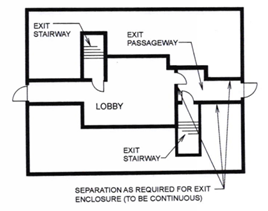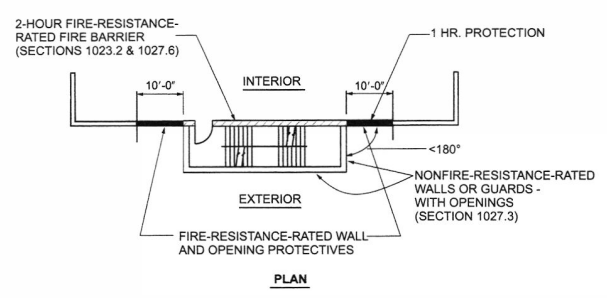Based on the definition of “exit” in the International Building Code, an exit is defined as “that portion of a means of egress system between the exit access and the exit discharge or public way.”
Exit components include exterior exit doors at the level of exit discharge, interior exit stairways and ramps, exit passageways, exterior exit stairways and ramps and horizontal exits.” These words are also defined in Chapter 2 of the IBC and are key elements in the means of egress system.
Essentially, the distance one travels to reach an exit is the exit access. The exit is the last element in the means of egress system before reaching the exit discharge (exterior door). There are several components to an exit which may impact the design of a floorplan. Here are a few examples:
Interior Exit Stairways and Ramps
An interior exit stairway is different that an exit access stairway as it may not have an associated fire-resistant rating.  Exit stairways and ramps will almost always have a fire resistive rating associated with them and that rating will vary depending on the number of floors the stair or ramp serves.
Exit stairways and ramps will almost always have a fire resistive rating associated with them and that rating will vary depending on the number of floors the stair or ramp serves.
If an interior exit stairway cannot discharge directly to an exit door, it may need to be connected to another exit component, such as an exit passageway, so that the fire protection can continue to the exit discharge.
Any opening into the exit stair must also be protected. While windows are permitted in exit doors; they just have to be tested as part of the door assembly. Windows are not permitted in an exit passageway, which is the next component.
Exit Passageways
Many buildings may include exit passageways instead of, or in addition to, an exit access stairway. This is where a building’s design may include an internal staircase which empties onto the first floor. The path leads to a corridor which leads to an exterior door. The level of fire protection must be maintained in this corridor as well. There is an illustration above indicates how this would occur in plan view.
Exterior Exits
An exterior stair is a staircase on the exterior of the building. Good examples of these are on many IKEA buildings or in the urban core.

The exterior stair can be used as a means of egress in buildings which are not high-rise buildings. The stair must be open on at least one side and be separated from the building with rated construction and protected openings.
The stair itself requires a two-hour fire barrier while the walls within ten feet of the exterior stair will require one-hour fire barriers. The second illustration shows how the stair would appear in section in terms of protection.
A means of egress system has many components; all of which serve a primary purpose of allowing people to exit a building in a safe manner in an emergency. While the means of egress system can sometimes be a challenge to particular design, leveraging these components effectively can allow your design to maintain your vision while complying with the code.
About the Author
Eirene Knott, MCP, CBO, CFM, has more than 20 years of experience working nationally with building and fire codes. She has written and presented code changes to clarify language in the code, as well as provided testimony on other proposed code changes. Prior to joining BRR, Eirene served as a Building Official, a Senior Plans Analyst and a Building Inspector. She has taught several codes-related courses at various conferences and the National Fire Academy. Email her.



